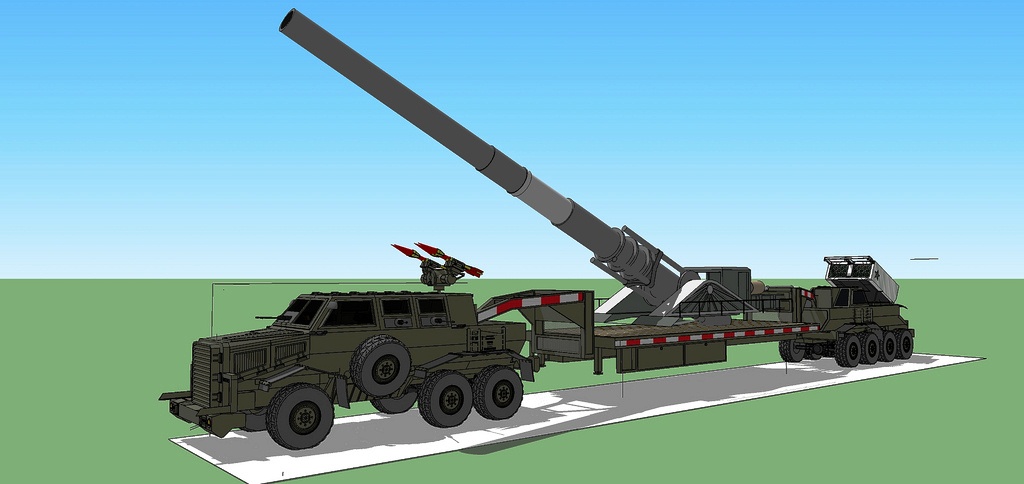
Terran British Royal Army. | M-200 Thunderclapp Artillery Rocker. | 
Terran British Royal Army. |
|---|
The M-200 was developed by the United Kingdoms for shore-based artillery support; The basic concept was a portable shore battery system. The main 200MM Mark 21 Artillery Gun (developed from the American 16"/50 caliber Mark 7 of the US Navy's IOWA-Class battleships) could reach up to 20 miles, with the necessary power to disable or destroy an incoming ship | Thunderclapp Artillery Rocker |
|---|
 | | An Artist's Conception Of The M-200 Thunderclapp Artillery Rocker. |
|---|
| Top Speed: | 30 knots. |
|---|
| Clearance: | 10 feet. |
|---|
| Beam: | 15 feet. |
|---|
| Length: | 25 feet. |
|---|
| Weight: | 1 ton. |
|---|
 | | Final Royal Army Approved Blueprint. |
|---|
of any sort- Even the much-vaunted American aircraft carriers, to the chagrin of the Americans. (The Brits themselves weren't really all that happy about it either; It meant all their own ships were susceptible, and the US suddenly began shying away from British ports, to the detriment of both.)The gun could be broken down and transported on a C-5 Galaxy with only one hour's notice (and an additional hour's set-up time after landing), with a minimum of fuel and no shells, or transported on any standard RO/RO (Roll On/Roll Off) with a full load. They could also be transported on any two standard rail cars, with the rocker on one car, the cabs on another. The gun could be fired in this mode, but only up to 10 degrees of dead-aligned to the car.The gun took about 25 minutes to emplace once positioned; The twin cabs would reach the area where the gun was required, the legs would extend from the table, then the table and carriage would be placed on the ground. The cabs could then be detached to other duties, or standby to move the gun again. (Contrary to popular misconception, both cabs were controlled from one station; While in transport mode, the cabs were controlled from the gun itself typically, though they could be controlled from either cab's cockpit. They used drive-by-wire, the exact same technology used in fly-by-wire aircraft technology, to co-ordinate the cabs, while the rocker went along for the ride.)Unfortunately, the M-200 suffered the same problem faced by the Americans in their Atomic Annie experiments; It was so big, the enemy couldn't help but see it, and would immediately attack them. However, it was still far more mobile than Atomic Annie, and had much the same range. Also, since there was no nuclear component, the M-200 could be inside it's own umbrella safely- Something Annie was unable to accomplish.The M-200 was never deployed outside the UK (the majority of them were positioned in Scotland, which the UK believed the Soviets had targeted for their invasion plans), with the exception of two units donated to the United States and Japan for testing and evaluation purposes; Both countries described it as an interesting program, but took a pass on implementation. More recently, the United Worlds Alliance (the precursor to the UGC) dusted off the concept, and with some significant modifications deployed them as mounts for L-35 Rail Launcher. Of particular interest in this regard was the M-200's unique carriage; The trunnion sat in a cradle in a bathtub-like housing called the frame, which rested on a retractable rotating pedestal. This gave the gun a 170 degree arc of fire (later increased to 200 degree), without having to reposition the gun itself, the crew simply lowered the pedestal until it took the weight of the emplacement, then raised the legs and turned the pedestal to the new alignment, lowered the legs and raised the pedestal (the gun could not be fired with the pedestal down as it was too fragile to use this way). The four extendable outriggers stabilized the platform during firing, even on uneven ground (though it was much easier on even ground). For movement, the pedestal and outriggers raised the frame to 3 feet 4 inches, where the tow vehicles called tractors could pull up under the frame's davits (the triangular sections that connected to the pins on the tractors), then lowered the frame onto the pins- An exercise that would take 5 minutes with a trained crew. The rotating pedestal was based on a design used in Swedish Vehicle Tunnel Fire Department engines to allow the fire engine itself to turn 180 degrees without forward and reverse movement- An advantage that could save as little as 5 minutes under some circumstances, but in the conditions of the tunnel could convert to hundreds dead or none at all. In current UGC service the M-35 does not have to retract the pedestal for firing, but the legs still have to be extended for stability; This seemingly minor advantage had major results as the gun could be trained and retrained much faster than the predecessors.Class: Mobile Ultra-Heavy Artillery.Crew: 14;Crew CommanderPilot: 2Heavy Artillery Gunner: 2A/A Gunners: 4Support Craft Drivers: 2 to 4.MDC By Location:The M-200 is actually a trinary system; It consists of the rocker (the boat-like unit the carriage sits in) and table (the component the rocker sits on), and two tractors, called cabs, which the rocker rests on for transportation. |
| Rocker: |
Hull-
Table- | 100
50 | Rocker Legs (4)-
Main Gun- | 50
50 |
| Cabs (2) |
Hull-
Cockpit- | 100
50 | Treads (2)-
Engine Compartment- | 50 each
50 |
| Speed and Statistical Data: |
Top Speed: 30 knots.
Clearance: 10 feet.
Beam: 15 feet.
Length: 25 feet.
Weight: 1 ton.
Cargo: Crew supplies only.
Cruise Range: Can operate up to 20 hours without support, but VERY rarely goes more than a few hours. | Power Plant: 2003 inch hydro-cell engines.
Propulsion: A massive fan, usually about 6 feet across with four blades.
Flight System: Grav pods, but not intended to fly per se.
Cost and Availability: 6,000credit; Takes about 6 months to build.
Black Market Cost and Availability: Could be as little as 10% to 10 times as much, and fairly popular.
|
| Weapons Systems: |
|---|
01. Main 200MM Artillery Gun: The 200MM artillery gun was the original purpose for the M-200; In fact, it is the artillery gun's size that gave the M-200 it's designation.
Purpose: Sector Control (basically smashes everything in it's sector).
Damage: 1D6 times 100SD/1D4 times 10 MD. (Though this is contradictory for normal damage stats, it is the M-200's stats.)
Blast Radius: 200 feet.
Range: 20 miles.
Rate of Fire: Can be fired every other melee.
Payload: The rocker itself can carry up to 10 shells; A support vehicle could carry up to 100. | 02. Secondary Weapons Systems: The M-200 was envisioned to be equipped with at least two secondary weapons systems, auto-cannons and/or SRM's. However, the 10 M-200's built by the British were never installed with these weapons for reasons that could never be specifically articulated.
|
| Features:For all its massive size and potential power, the Thunderclapp really doesn't have that much in the way of features; Anti-Missile flares only served to illuminate the platform better, as did most active sensors and defensive measures. |
- ESM: Radar Detector. Passively detects other radars being operated.
- Anti-Jamming System: Reduces Electronics Countermeasure by 75% (decrease skill level appropriately).
- Full Range Sensory Suite: Infrared, ultra violet, Magnification, night sight, color filters, thermal imager. Range is about 2,000 miles for MOST sensors.
- MRA 6 Radios: Allows real time, continuous radio link up with friendly forces in the area via satellite relay over laser radio signals, preventing jamming, and automatically encrypts/decrypts same to prevent eavesdropping.
- Type-11 wide band radios: Effective 10 mile range, auto encrypt/decrypt. Works on radio band wavelengths, so it can still be jammed (if the enemy knows the frequencies).
- Combat/Targeting Computer: Records all enemy and friendly activity over the course of time; Can replay that activity for the pilot, assign target designation numbers, and track likely damage based on mathematical formulas (i.e. "Right leg red" badly damaged/destroyed, "head green" not damaged, etc). Displays this information as a pop up in the HUD on request by the pilot. It can also track the status of friendly forces in there area if their IFF Transponders are on line.
- Motion Detector: Activates a loud wailing when an object is coming at the user fast, and a soft ringing if it's coming slowly. Activation ranges must be specified by the pilot.
| - Loudspeaker: Amplifies voice 1 to 100 times. 100' in normal crowds.
- Blue Force Tracker: Identifies Friend from Foe. Overlays the information on both the radar and HUD, ensuring that friendly forces are not accidentally targeted.
- Video Recorder: Records from sensors and the cockpit itself. 500 hours of recording available.
- HUD: Displays maps, radar, targeting information, and any OTHER information the wearer wants directly in front of the user.
- Virtual Map: Displays a continuously-updating map of local terrain for the pilot. Effective land navigation of 85% as updates come. Good to 50 miles. Specific range can be adjusted in 1 mile increments.
- Survival Packs: Several packs of simpler emergency survival supplies: Pup tent, sleeping bag, black light, G.P.S., first aid kit (bandages, gauze, bandage tape, pads, antiseptic/analgesic), plasma torch (for small repairs and starting fires), repair kit (with M.D.C. Repair Spray), sewing kit (a small spool of thread and 5 needles), 7 star flares (250' apogee), 2 white parachute flares (1,500' apogee), 100' of black or brown parachute cord (150 lbs tensile strength), 2-5 days rations, 2 gallons water, water purification kit- good for about 10 gallons.
- Variable Tint Cockpit Canopy (cabs only): Adjusts tinting to light conditions, up to an including a black dot if the sun is directly on the pilots face (only covers eyes).
|
Combat Profile for M-200 Thunderclapp Artillery Rocker:- +10 Strike, but requires several minutes to aim; Also only useful against large objects (over 80 feet) or to target areas, rather than objects.
- Automatic Initiative (objects big enough for this to hit, can't hide their approach for long).
Note: The Thunderclapp has NO Dodge, Roll, or Parry. It's a sitting duck, especially once emplaced (all enemies are +3 to strike). |



